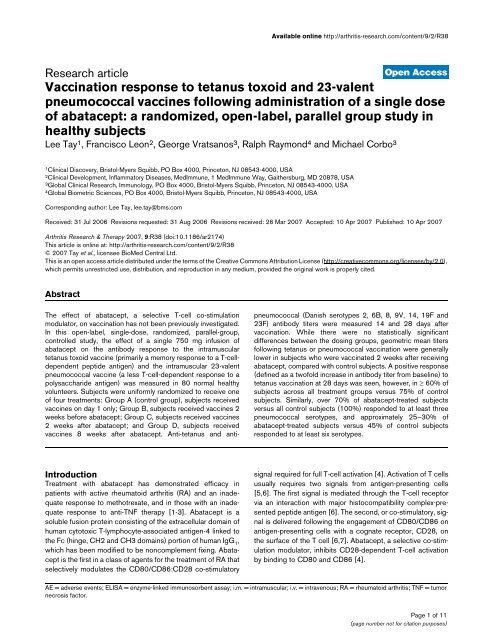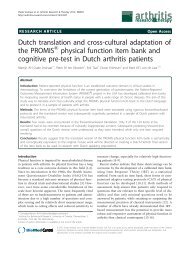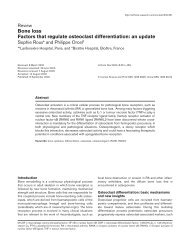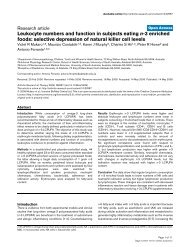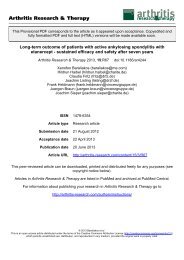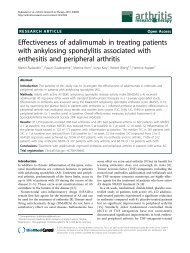Vaccination response to tetanus toxoid and 23 ... - BioMed Central
Vaccination response to tetanus toxoid and 23 ... - BioMed Central
Vaccination response to tetanus toxoid and 23 ... - BioMed Central
Create successful ePaper yourself
Turn your PDF publications into a flip-book with our unique Google optimized e-Paper software.
Available online http://arthritis-research.com/content/9/2/R38Vol 9 No 2Research article<strong>Vaccination</strong> <strong>response</strong> <strong>to</strong> <strong>tetanus</strong> <strong>to</strong>xoid <strong>and</strong> <strong>23</strong>-valentpneumococcal vaccines following administration of a single doseof abatacept: a r<strong>and</strong>omized, open-label, parallel group study inhealthy subjectsLee Tay 1 , Francisco Leon 2 , George Vratsanos 3 , Ralph Raymond 4 <strong>and</strong> Michael Corbo 3Open Access1 Clinical Discovery, Bris<strong>to</strong>l-Myers Squibb, PO Box 4000, Prince<strong>to</strong>n, NJ 08543-4000, USA2Clinical Development, Inflamma<strong>to</strong>ry Diseases, MedImmune, 1 MedImmune Way, Gaithersburg, MD 20878, USA3Global Clinical Research, Immunology, PO Box 4000, Bris<strong>to</strong>l-Myers Squibb, Prince<strong>to</strong>n, NJ 08543-4000, USA4 Global Biometric Sciences, PO Box 4000, Bris<strong>to</strong>l-Myers Squibb, Prince<strong>to</strong>n, NJ 08543-4000, USACorresponding author: Lee Tay, lee.tay@bms.comReceived: 31 Jul 2006 Revisions requested: 31 Aug 2006 Revisions received: 26 Mar 2007 Accepted: 10 Apr 2007 Published: 10 Apr 2007Arthritis Research & Therapy 2007, 9:R38 (doi:10.1186/ar2174)This article is online at: http://arthritis-research.com/content/9/2/R38© 2007 Tay et al., licensee <strong>BioMed</strong> <strong>Central</strong> Ltd.This is an open access article distributed under the terms of the Creative Commons Attribution License (http://creativecommons.org/licenses/by/2.0),which permits unrestricted use, distribution, <strong>and</strong> reproduction in any medium, provided the original work is properly cited.AbstractThe effect of abatacept, a selective T-cell co-stimulationmodula<strong>to</strong>r, on vaccination has not been previously investigated.In this open-label, single-dose, r<strong>and</strong>omized, parallel-group,controlled study, the effect of a single 750 mg infusion ofabatacept on the antibody <strong>response</strong> <strong>to</strong> the intramuscular<strong>tetanus</strong> <strong>to</strong>xoid vaccine (primarily a memory <strong>response</strong> <strong>to</strong> a T-celldependentpeptide antigen) <strong>and</strong> the intramuscular <strong>23</strong>-valentpneumococcal vaccine (a less T-cell-dependent <strong>response</strong> <strong>to</strong> apolysaccharide antigen) was measured in 80 normal healthyvolunteers. Subjects were uniformly r<strong>and</strong>omized <strong>to</strong> receive oneof four treatments: Group A (control group), subjects receivedvaccines on day 1 only; Group B, subjects received vaccines 2weeks before abatacept; Group C, subjects received vaccines2 weeks after abatacept; <strong>and</strong> Group D, subjects receivedvaccines 8 weeks after abatacept. Anti-<strong>tetanus</strong> <strong>and</strong> antipneumococcal(Danish serotypes 2, 6B, 8, 9V, 14, 19F <strong>and</strong><strong>23</strong>F) antibody titers were measured 14 <strong>and</strong> 28 days aftervaccination. While there were no statistically significantdifferences between the dosing groups, geometric mean titersfollowing <strong>tetanus</strong> or pneumococcal vaccination were generallylower in subjects who were vaccinated 2 weeks after receivingabatacept, compared with control subjects. A positive <strong>response</strong>(defined as a twofold increase in antibody titer from baseline) <strong>to</strong><strong>tetanus</strong> vaccination at 28 days was seen, however, in ≥ 60% ofsubjects across all treatment groups versus 75% of controlsubjects. Similarly, over 70% of abatacept-treated subjectsversus all control subjects (100%) responded <strong>to</strong> at least threepneumococcal serotypes, <strong>and</strong> approximately 25–30% ofabatacept-treated subjects versus 45% of control subjectsresponded <strong>to</strong> at least six serotypes.IntroductionTreatment with abatacept has demonstrated efficacy inpatients with active rheuma<strong>to</strong>id arthritis (RA) <strong>and</strong> an inadequate<strong>response</strong> <strong>to</strong> methotrexate, <strong>and</strong> in those with an inadequate<strong>response</strong> <strong>to</strong> anti-TNF therapy [1-3]. Abatacept is asoluble fusion protein consisting of the extracellular domain ofhuman cy<strong>to</strong><strong>to</strong>xic T-lymphocyte-associated antigen-4 linked <strong>to</strong>the Fc (hinge, CH2 <strong>and</strong> CH3 domains) portion of human IgG 1 ,which has been modified <strong>to</strong> be noncomplement fixing. Abataceptis the first in a class of agents for the treatment of RA thatselectively modulates the CD80/CD86:CD28 co-stimula<strong>to</strong>rysignal required for full T-cell activation [4]. Activation of T cellsusually requires two signals from antigen-presenting cells[5,6]. The first signal is mediated through the T-cell recep<strong>to</strong>rvia an interaction with major his<strong>to</strong>compatibility complex-presentedpeptide antigen [6]. The second, or co-stimula<strong>to</strong>ry, signalis delivered following the engagement of CD80/CD86 onantigen-presenting cells with a cognate recep<strong>to</strong>r, CD28, onthe surface of the T cell [6,7]. Abatacept, a selective co-stimulationmodula<strong>to</strong>r, inhibits CD28-dependent T-cell activationby binding <strong>to</strong> CD80 <strong>and</strong> CD86 [4].AE = adverse events; ELISA = enzyme-linked immunosorbent assay; i.m. = intramuscular; i.v. = intravenous; RA = rheuma<strong>to</strong>id arthritis; TNF = tumornecrosis fac<strong>to</strong>r.Page 1 of 11(page number not for citation purposes)
Arthritis Research & Therapy Vol 9 No 2 Tay et al.The impact of abatacept on humoral <strong>response</strong>s <strong>to</strong> two T-celldependentneoantigens, bacteriophage X174 <strong>and</strong> keyhole limpethemocyanin, was previously evaluated in psoriasis patientstreated with abatacept [8]. While the <strong>response</strong>s <strong>to</strong> theseneoantigens were reduced, the primary <strong>response</strong> <strong>to</strong> these T-cell-dependent antigens was not completely blocked. In addition,tertiary <strong>and</strong> quaternary <strong>response</strong>s were res<strong>to</strong>red followingdiscontinuation of abatacept administration, demonstratingthat <strong>to</strong>lerance <strong>to</strong> these neoantigens was not induced [8].In the present article we describe the effect of a single dose ofabatacept on the humoral <strong>response</strong> in healthy subjects <strong>to</strong> twovaccines, <strong>tetanus</strong> <strong>to</strong>xoid vaccine <strong>and</strong> <strong>23</strong>-valent pneumococcalvaccine. This study was carried out in normal healthy subjectsin order <strong>to</strong> evaluate the effects of abatacept on the <strong>response</strong><strong>to</strong> therapeutic vaccines in intact immune systems before evaluatingthe <strong>response</strong> in RA patients. Patients with active RAmay not have normal immune function parameters, <strong>and</strong> oftenreceive background disease-modifying antirheumatic drugs,many of which are immunosuppressive. It was intended thatdata from this study would guide the design of other studiesevaluating vaccine <strong>response</strong>s in patients with RA. These criticalstudies in 'real-world' RA patients are ongoing. In addition,the effect of abatacept upon two different types of antigen<strong>response</strong> was evaluated. The <strong>tetanus</strong> <strong>to</strong>xoid vaccine comprisesa peptide antigen, <strong>and</strong>, since most individuals in theUnited States have been vaccinated with <strong>tetanus</strong> <strong>to</strong>xoid, the<strong>response</strong> measured in this study can be considered a T-celldependentmemory <strong>response</strong>. Polysaccharides, however, areable <strong>to</strong> elicit <strong>response</strong>s in the absence of T-cell help, althoughthe magnitude of the <strong>response</strong> is reduced under those circumstances[9-11]. The <strong>response</strong> <strong>to</strong> pneumococcal vaccinemeasured in the present study is therefore not entirely T-cellindependent, or the <strong>response</strong> is less T-cell dependent. Finally,as a normal humoral <strong>response</strong> <strong>to</strong> T-cell-dependent antigenspeaks at around 2 weeks [12], we also analyzed the impact onhumoral <strong>response</strong> of the timing of vaccination relative <strong>to</strong> abataceptadministration.Materials <strong>and</strong> methodsStudy designThis open-label, parallel-group, controlled study was conductedat three study centers in the United States. Subjectswere r<strong>and</strong>omized <strong>to</strong> one of four treatment groups (Figure 1).Group A (control group) subjects received separate 0.5 mlintramuscular (i.m.) injections of <strong>tetanus</strong> <strong>to</strong>xoid <strong>and</strong> <strong>23</strong>-valentpneumococcal vaccines on day 1 without abatacept.Group B subjects (vaccines 2 weeks before abatacept)received separate 0.5 ml i.m. injections of <strong>tetanus</strong> <strong>to</strong>xoid <strong>and</strong><strong>23</strong>-valent pneumococcal vaccines on day 1, followed 14 dayslater by a single intravenous (i.v.) dose of 750 mg abatacept.Serum samples were collected prior <strong>to</strong> the abatacept infusionon study day 14 <strong>and</strong> 14 days later on study day 28.Group C subjects (vaccines 2 weeks after abatacept)received a single i.v. dose of 750 mg abatacept on day 1, followed14 days later by separate 0.5 ml i.m. injections of <strong>tetanus</strong><strong>to</strong>xoid <strong>and</strong> <strong>23</strong>-valent pneumococcal vaccines. Serumsamples were obtained on study day 14 prior <strong>to</strong> vaccinations<strong>and</strong> at 14 <strong>and</strong> 28 days after the vaccinations (study days 28<strong>and</strong> 42, respectively).Figure 1Patient disposition from enrollment <strong>to</strong> completion of the trial. *Abatacept administered after immunoglobulin (Ig) determination at day 14.Page 2 of 11(page number not for citation purposes)
Available online http://arthritis-research.com/content/9/2/R38Group D subjects (vaccines 8 weeks after abatacept)received a single i.v. dose of 750 mg abatacept on day 1,followed 56 days later by separate 0.5 ml i.m. injections of <strong>tetanus</strong><strong>to</strong>xoid <strong>and</strong> <strong>23</strong>-valent pneumococcal vaccines.Serum samples were obtained for subjects of Groups A <strong>and</strong>B at study days 14 <strong>and</strong> 28, for Group C subjects at study days28 <strong>and</strong> 42, <strong>and</strong> for Group D subjects at study days 70 <strong>and</strong> 84.Healthy male or female subjects (aged 18–65 years inclusive)with a body weight ≥ 60 kg <strong>and</strong> ≤ 100 kg were enrolled. Subjectswere excluded if they had received any live vaccine withinthe prior 4 weeks, had received a <strong>tetanus</strong> booster or pneumococcalvaccine within 5 years or if they had baseline anti-<strong>tetanus</strong>antibodies below clinically detectable levels. Anti-<strong>tetanus</strong><strong>and</strong> anti-pneumococcal (Danish serotypes 2, 6B, 8, 9V, 14,19F <strong>and</strong> <strong>23</strong>F) antibody titers were measured by ELISA at 14<strong>and</strong> 28 days after vaccination by a central labora<strong>to</strong>ry. Abataceptserum concentrations were measured at the same timeas the antibody titers were determined.This study was carried out in accordance with the ethical principlesof the Declaration of Helsinki <strong>and</strong> was approved by InstitutionalReview Boards. All subjects gave informed consent.Drug administration <strong>and</strong> vaccinationAbatacept 750 mg was administered over 30 minutes by i.v.infusion using a calibrated, constant-rate infusion. Tetanus <strong>to</strong>xoidvaccine (Aventis Pasteur Inc., Swiftwater, PA, USA) <strong>and</strong><strong>23</strong>-valent pneumococcal vaccines (Merck & Co Inc., WhitehouseStation, NJ, USA) were administered separately via i.m.injection in either the del<strong>to</strong>id or the lateral mid-thigh.Abatacept <strong>and</strong> antibody assaysSerum samples were used <strong>to</strong> determine antibody levels. Theassay <strong>to</strong> quantify IgG anti-<strong>tetanus</strong> <strong>to</strong>xoid antibody levels wasbased on a previously described methodology [13]. The assay<strong>to</strong> quantify IgG anti-pneumococcal antibody levels was basedon the Procedures of the World Health Organization PneumococcalSerology Reference Labora<strong>to</strong>ries at the Institute ofChild Health, University College, London, UK, <strong>and</strong> on the proceduresof the Department of Pathology, University of Alabamaat Birmingham, AL, USA [14]. All analyses were carriedout at the Center for Vaccine Research <strong>and</strong> Development, StLouis University Health Sciences Center, St Louis, MO, USA.The antibody <strong>response</strong> against <strong>tetanus</strong> <strong>to</strong>xoid vaccine wasexpressed as absolute titers of antibodies. Serum samples forthe quantification of abatacept were collected at baseline,prior <strong>to</strong> vaccinations, <strong>and</strong> at the time when the samples werecollected for antibody determinations [15].Safety assessmentsSubjects were moni<strong>to</strong>red for adverse events (AE), serious AE<strong>and</strong> vital signs prior <strong>to</strong> dosing with abatacept <strong>and</strong> upondiscontinuation.Statistical methodsAll subjects in all four groups were included in the safety analysis.Geometric means <strong>and</strong> the percentage of the coefficien<strong>to</strong>f variation were reported for antibody concentrations. Foreach antibody, point estimates <strong>and</strong> 95% confidence intervalswere constructed for the geometric mean changes from prevaccination<strong>to</strong> postvaccination antibody levels. These constructionswere from the results of repeated-measuresanalyses of covariance on the natural logarithm of the antibodylevels, with the treatment group <strong>and</strong> the study day as fac<strong>to</strong>rs<strong>and</strong> the log of the baseline (prevaccination) antibody level asthe covariate. For each antibody, point estimates <strong>and</strong> 95%confidence intervals for the prevaccination <strong>to</strong> postvaccinationchanges on the log scale were exponentiated <strong>to</strong> obtain estimatesfor geometric means <strong>and</strong> ratios of geometric means(fold increase) on the original scale. A twofold or higherincrease above the baseline levels of specific antibodies wasconsidered a clinically significant or positive immune <strong>response</strong>against <strong>tetanus</strong> <strong>to</strong>xoid <strong>and</strong> <strong>to</strong> each of the seven chosen serotypesof the <strong>23</strong>-valent pneumococcal vaccine [16,17].ResultsThe baseline demographics <strong>and</strong> clinical characteristics of the80 subjects enrolled in this study were similar across the fourgroups. The mean age of subjects was 34–36 years (Table 1).Of the 80 subjects, 77 (96%) completed treatment <strong>and</strong> three(4%) discontinued early from the study.Overall, 59 AE were experienced by 29 subjects (49.2%)treated with abatacept, compared with 25 AE reported in 13subjects (65.0%) who did not receive abatacept (Group A,control group). The most frequently reported AE in Group Asubjects were injection-site pain (50.0%), headache (10.0%)<strong>and</strong> pharyngolaryngeal pain (10.0%). The most frequentlyreported treatment-emergent AE in the abatacept-treatedgroups were headache (20.3%), injection-site pain (10.2%)<strong>and</strong> viral infection (10.2%).One subject (1.7%) in Group D experienced a serious adverseevent of generalized urticaria 5 minutes after the end of thefirst abatacept infusion, which re-occurred at 90 minutespostinfusion. The investiga<strong>to</strong>r reported the event as moderatein intensity <strong>and</strong> probably related <strong>to</strong> the study drug. The subjectwas treated with epinephrine <strong>and</strong> diphenhydramine, remainedhospitalized overnight for observation <strong>and</strong> was discharged onstudy day 2. The event was completely resolved by study day3.Page 3 of 11(page number not for citation purposes)
Arthritis Research & Therapy Vol 9 No 2 Tay et al.Table 1Subject demographicsCharacteristicGroup A (vaccines alone on day1) (n = 20)Group B (vaccines 2 weeksbefore abatacept) (n = 20)Group C (vaccines 2 weeks afterabatacept) (n = 20)Group D (vaccines 8 weeks afterabatacept) (n = 20)Age (years)Mean 34 34 34 36St<strong>and</strong>ard deviation 12 13 11 13Range 18–55 18–56 19–56 20–56Gender (n (%))Male 10 (50) 8 (40) 10 (50) 11 (55)Female 10 (50) 12 (60) 10 (50) 9 (45)Race (n (%))White 15 (75) 12 (60) 14 (70) 11 (55)Black 5 (25) 8 (40) 6 (30) 8 (40)Other 0 0 0 1 (5)Abatacept serum concentration levelsThe observed abatacept serum concentrations levels wereconsistent with the dose of abatacept administered <strong>and</strong> its relativetiming.Subjects r<strong>and</strong>omized <strong>to</strong> Group A (control group, vaccinesonly) did not receive abatacept, as reflected in Table 2. Subjectsr<strong>and</strong>omized <strong>to</strong> Group B received vaccines 2 weeks prior<strong>to</strong> treatment with abatacept. In this group, serum sampleswere collected prior <strong>to</strong> the abatacept infusion on study day 14<strong>and</strong> on study day 28. This is reflected in serum concentrationsbelow the lower limit of quantification on day 14, <strong>and</strong> a meanserum concentration of 28.6 μg/ml on study day 28.Subjects r<strong>and</strong>omized <strong>to</strong> Group C received vaccines 2 weeksafter treatment with abatacept. The mean serum concentrationsobserved for subjects in this group – taken 14 <strong>and</strong> 28days after vaccinations of 12.5 μg/ml <strong>and</strong> 6.1 μg/ml, respectively– are again consistent with values at the correspondingtime points in previous studies in healthy subjects.Finally, subjects r<strong>and</strong>omized <strong>to</strong> Group D received vaccines 8weeks after treatment with abatacept. The observed meanserum concentrations of 1.3 μg/ml on study day 70 is consistentwith concentration levels obtained in previous studies. Furthermore,the mean serum concentration of 0.4 μg/ml on studyday 84 is consistent with concentrations that would beexpected based on a half-life of approximately 14 days forabatacept.Antibody <strong>response</strong>s in the control groupIn the control group (Group A), not all normal, healthy subjectsresponded fully <strong>to</strong> the two vaccines at day 14 <strong>and</strong> 28. For the<strong>tetanus</strong> <strong>to</strong>xoid, approximately 95% <strong>and</strong> 75% of subjects atdays 14 <strong>and</strong> 28, respectively, achieved at least a twofoldincrease in antibody titers. For the pneumococcal vaccine,Table 2Abatacept serum concentration levels determined 14 <strong>and</strong> 28 days after vaccinationGroup Baseline (μg/ml) 14 days after vaccination (μg/ml) 28 days after vaccination (μg/ml)Group A a (vaccines alone on day 1) N/A N/A N/AGroup B b (vaccines 2 weeks before abatacept) N/A N/A 28.6 (26)Group C (vaccines 2 weeks after abatacept) N/A 12.5 (19) 6.1 (20)Group D (vaccines 8 weeks after abatacept) N/A 1.3 (56) 0.4 (106)Data presented as the geometric means (percentage of the coefficient of variation. N/A: not applicable. a Subjects in Group A did not receiveabatacept. b Subjects in Group B received abatacept at 14 days (serum concentration taken pre-abatacept dosing).Page 4 of 11(page number not for citation purposes)
Available online http://arthritis-research.com/content/9/2/R38Table 3Geometric means (percentage of the coefficient of variation) of anti-<strong>tetanus</strong> <strong>to</strong>xoid antibody titers taken 14 <strong>and</strong> 28 days after<strong>tetanus</strong> <strong>to</strong>xoid vaccinationGroup n Baseline titers (U/ml) Anti-<strong>tetanus</strong> antibody titers at 14 dayspost-vaccination (U/ml)Anti-<strong>tetanus</strong> antibody titers at 28 dayspost-vaccination (U/ml)Group A (vaccines alone on day 1) 20 1.6 (106) 11.4 (88) 9.3 (104)Group B (vaccines 2 weeks before abatacept) 20 1.9 (76) 10.2 (71) 8.7 (68) aGroup C (vaccines 2 weeks after abatacept) 19 b 2.3 (76) 5.9 (112) 5.6 (98)Group D (vaccines 8 weeks after abatacept) 19 c 2.3 (54) 9.0 (79) 7.8 (85)a n = 19 as one subject discontinued due <strong>to</strong> an adverse event (this discontinued patient only had samples collected at baseline <strong>and</strong> day 14).bSubject discontinued prior <strong>to</strong> vaccine administration on day 14 due <strong>to</strong> <strong>to</strong>xicology. c Subject discontinued prior <strong>to</strong> vaccine administration on day 56due <strong>to</strong> <strong>to</strong>xicology.approximately 45–95% <strong>and</strong> 50–95% of subjects at days 14<strong>and</strong> 28, respectively, achieved at least a twofold increase inantibody titer across all seven serotypes.Antibody <strong>response</strong> <strong>to</strong> <strong>tetanus</strong> <strong>to</strong>xoidThe antibody <strong>response</strong>s against <strong>tetanus</strong> <strong>to</strong>xoid vaccine,expressed as absolute titers of antibodies, are summarized inTable 3. The corresponding abatacept serum concentrationsare presented in Table 2.The intersubject variability in <strong>response</strong> <strong>to</strong> <strong>tetanus</strong> <strong>to</strong>xoid waslarge, with the percentage of the coefficient of variation rangingbetween 54% <strong>and</strong> 112% (Table 3). Based on the geometricmean of the antibody titers, subjects in Group B (receivedvaccines 2 weeks before abatacept) appeared little affected <strong>to</strong>not affected, with a lowered <strong>response</strong> of approximately 6%when compared with the control group (Group A) at 28 daysafter vaccination, a reduction within the variability of the assay(Table 3). For Group C subjects (received vaccines 2 weeksafter abatacept), there appeared <strong>to</strong> be a lowered <strong>response</strong> ofapproximately 48% <strong>and</strong> 39% at 14 <strong>and</strong> 28 days, respectively,compared with Group A. Subjects in Group D (received vaccines8 weeks after abatacept) were affected <strong>to</strong> a lesserextent, with an observed lowered <strong>response</strong> of approximately21% <strong>and</strong> 16% at 14 <strong>and</strong> 28 days, respectively, compared withGroup A.The percentage of subjects who mounted a <strong>response</strong> that wasat least twofold from baseline is shown in Figure 2 for <strong>tetanus</strong><strong>to</strong>xoid. Across all treatment groups, at least 60% of subjectswere able <strong>to</strong> generate at least a twofold increase in antibody<strong>response</strong> after 28 days. In the control group (Group A), 75%of subjects reached this level. The <strong>response</strong>s observed at 14<strong>and</strong> 28 days after vaccination were similar.Antibody <strong>response</strong>s <strong>to</strong> <strong>23</strong>-valent pneumococcal vaccineSeven serotypes of <strong>23</strong>-valent pneumococcal vaccine werechosen as a representative sample of differing immunogenicstrengths of pneumococcal vaccine. Serotype 14 (the mostcommon), serotype 8, serotype 9V <strong>and</strong> serotype 2 are themost immunogenic. Figure 3 illustrates the fold increases forthe seven serotypes at days 14 <strong>and</strong> 28, respectively, <strong>and</strong>Table 4 presents the corresponding geometric mean values ofantibody titers.As with the <strong>response</strong> <strong>to</strong> <strong>tetanus</strong> <strong>to</strong>xoid, variable <strong>response</strong> rateswere obtained in the study subjects across individual serotypes.The percentages of subjects in all treatment groupsachieving a positive <strong>response</strong> <strong>to</strong> the different serotypes at 14<strong>and</strong> 28 days after vaccination are illustrated in Figure 4a <strong>and</strong>4b, respectively. In general, <strong>and</strong> as expected, the highest<strong>response</strong>s were observed for serotypes 14 <strong>and</strong> 2. The apparentdecrease in vaccination <strong>response</strong> in subjects who were inGroup B cannot be accurately evaluated because of thehigher baseline values obtained in these subjects, a knowncause of reduced relative <strong>response</strong>s. This r<strong>and</strong>omization variabilityis further illustrated by the fact that <strong>response</strong>s in GroupB subjects appeared decreased even at day 14, prior <strong>to</strong> theadministration of abatacept. In subjects of Groups C <strong>and</strong> D,however – those who were vaccinated after abatacept – loweraverage titers on days 14 <strong>and</strong> 28 were recorded for allserotypes, except serotype <strong>23</strong>F (Table 4). The decrease inantibody <strong>response</strong> in Group C subjects at 14 <strong>and</strong> 28 daysafter vaccination ranged from 22% <strong>to</strong> 69% <strong>and</strong> from 24% <strong>to</strong>68%, respectively. Similarly, the decrease in antibody<strong>response</strong> for subjects in Group D determined at 14 <strong>and</strong> 28days after vaccination ranged between 12% <strong>and</strong> 67% <strong>and</strong>between 25% <strong>and</strong> 64%, respectively. No correlation betweenthe immunogenicity of the serotype of the pneumococcal vaccine<strong>and</strong> the reduction in <strong>response</strong> was observed.Figure 5a,b summarizes the number of serotypes <strong>to</strong> whichsubjects responded with at least a twofold increase over baselineat 14 <strong>and</strong> 28 days after vaccination, respectively. Morethan 90% of subjects in all treatment groups responded <strong>to</strong> atleast one serotype, over 70% of subjects responded <strong>to</strong> at leastthree different serotypes, <strong>and</strong> approximately 25% of subjectsresponded <strong>to</strong> at least six different serotypes by day 14 (Figure5a) <strong>and</strong> by day 28 (Figure 5b).Page 5 of 11(page number not for citation purposes)
Arthritis Research & Therapy Vol 9 No 2 Tay et al.Figure 2Percentage of subjects achieving at least a twofold increase in <strong>tetanus</strong> <strong>to</strong>xoid antibodies from baseline.DiscussionThe purpose of this study was <strong>to</strong> investigate the effect ofabatacept on the antibody <strong>response</strong> in healthy subjects prior<strong>to</strong> initiating studies in RA patients. Tetanus <strong>to</strong>xoid vaccine <strong>and</strong>the <strong>23</strong>-valent pneumococcal vaccine were used <strong>to</strong> assess theimpact of abatacept on a memory <strong>response</strong> <strong>to</strong> a T-celldependentprotein antigen <strong>and</strong> <strong>to</strong> a less T-cell-dependentpolysaccharide antigen, respectively. Finally, the correlation ofany effect regarding the timing of abatacept administration relative<strong>to</strong> the administration of each vaccine was evaluated.The geometric mean titers were reduced for both vaccines,suggesting that abatacept does blunt the immune <strong>response</strong> <strong>to</strong>these vaccines. This effect on the <strong>response</strong> occurred <strong>to</strong> differingextents among the groups. For the <strong>tetanus</strong> <strong>to</strong>xoid vaccine,Group C subjects (vaccines 2 weeks after abatacept)appeared <strong>to</strong> be the more affected of the three treatmentgroups, compared with Group A subjects (control group).Subjects in Group D (vaccines 8 weeks after abatacept) wereaffected <strong>to</strong> a lesser extent than those in Group C, <strong>and</strong> GroupB subjects were the least affected.For the <strong>23</strong>-valent pneumococcal vaccine, there appeared <strong>to</strong>be lower titers for all serotypes, except serotype <strong>23</strong>F, in subjectsof Group C (vaccines 2 weeks after abatacept) <strong>and</strong> ofGroup D (vaccines 8 weeks after abatacept). The apparentdecrease in vaccination <strong>response</strong> in subjects in Group B cannotbe accurately evaluated because of the higher baselinevalues obtained in these subjects.While abatacept reduced the <strong>response</strong> (geometric mean titers)of the two vaccines, it did not significantly inhibit the abilityof healthy subjects <strong>to</strong> develop at least a twofold <strong>response</strong> <strong>to</strong>either the <strong>tetanus</strong> <strong>to</strong>xoid or <strong>23</strong>-valent pneumococcal vaccine.Overall, across all treatment groups, >60% subjects wereable <strong>to</strong> generate at least a twofold increase in antibody<strong>response</strong> <strong>to</strong> <strong>tetanus</strong> <strong>to</strong>xoid after day 28, <strong>and</strong> over 70% of subjectsin all treatment groups responded <strong>to</strong> at least three serotypesof the pneumococcal vaccine; in addition, approximately25% of all treated subjects responded <strong>to</strong> at least six serotypes– an expected <strong>and</strong> normal <strong>response</strong> in healthy subjects[18,19].The role of abatacept in the reduction of the geometric meantiters is supported by the relationship between serum levels ofabatacept present at the time of vaccination <strong>and</strong> the degree ofinhibition of the humoral <strong>response</strong>. The most affected group inthis study was Group C (vaccine 2 weeks after abatacept). Inthis group, the highest abatacept levels (<strong>and</strong> presumably ahigher degree of co-stimulation blockade) were observed atthe time of vaccination. By contrast, the observed mean serumconcentration for Group D subjects (vaccine 8 weeks afterabatacept) was very low at the time of vaccination <strong>and</strong> wasless affected. Group B subjects (vaccine 2 weeks beforePage 6 of 11(page number not for citation purposes)
Available online http://arthritis-research.com/content/9/2/R38Figure 3Impact of abatacept on antibody titers at 14 <strong>and</strong> 28 days after vaccination in individual pneumococcal serotypes.abatacept) appeared <strong>to</strong> be least affected, at least for the <strong>tetanus</strong><strong>to</strong>xoid. This may be due <strong>to</strong> the fact that a peak antibodyconcentration in a normal primary immune <strong>response</strong> isachieved at around 2 weeks [12], <strong>and</strong> in Group B subjectsthere was presumably a pool of B cells that had completedtheir differentiation in<strong>to</strong> antibody-secreting plasma cells beforeabatacept was administered.Abatacept prevents the activation of naive T cells by inhibitingthe second signal required for their co-stimulation. This signalis mediated by CD80 <strong>and</strong> CD86, which is expressed on antigen-presentingcells, <strong>and</strong> by CD28, which is expressed on Tcells. Abatacept may also reduce the activation of memory Tcells (although <strong>to</strong> a lesser extent than for naïve T cells) [20].This is consistent with a reduced <strong>response</strong> against <strong>tetanus</strong><strong>to</strong>xoid. The inhibition of the CD80/CD86:CD28 co-stimula<strong>to</strong>rysignal may also potentially prevent the T-cell 'help' needed foroptimal differentiation of CD80/CD86-expressing B cells in<strong>to</strong>plasma cells, which ultimately secrete antibodies. This inhibitionof B cell–T cell help may be a reason for the reducedantibody <strong>response</strong> <strong>to</strong> thymus-independent polysaccharideantigens such as those contained in the pneumococcal vaccine– <strong>response</strong>s that cannot be considered completely T-cellindependent since they are enhanced by T-cell help [9,11].Finally, since abatacept inhibits one of several media<strong>to</strong>rs of costimulation,the partial inhibition observed here is likely <strong>to</strong>reflect the redundancy of the co-stimulation mechanism.This study analyzed the <strong>response</strong> in healthy volunteers with anormal immune system <strong>to</strong> a single dose of abatacept. Futurestudies are needed <strong>to</strong> determine the optimal timing ofPage 7 of 11(page number not for citation purposes)
Arthritis Research & Therapy Vol 9 No 2 Tay et al.Table 4Geometric means (percentage of the coefficient of variation) of antibody titers taken 14 <strong>and</strong> 28 days after pneumococcalvaccinationGroup n Baseline (μg/ml) 14 days post-vaccination (μg/ml) 28 days post-vaccination (μg/ml)Serotype 14Group A 20 1.9 (112) 20.5 (<strong>23</strong>6) <strong>23</strong>.5 (199)Group B 20 1.9 (132) 15.5 (105) 15.4 (111) aGroup C 19 1.8 (201) 12.0 (195) 12.8 (250)Group D 19 1.8 (125) 18.0 (155) 12.6 (141)Serotype 2Group A 20 1.0 (163) 13.4 (113) 15.4 (110)Group B 20 1.1 (84) 12.3 (109) 13.2 (107) aGroup C 19 0.8 (90) 4.1 (118) 4.8 (115)Group D 19 0.7 (122) 7.0 (132) 7.7 (136)Serotype <strong>23</strong>FGroup A 20 0.9 (101) 3.0 (112) 3.3 (113)Group B 20 1.8 (124) 5.6 (87) 4.9 (89) aGroup C 19 1.2 (158) 4.5 (112) 5.1 (106)Group D 19 1.5 (125) 6.2 (92) 6.7 (90)Serotype 8Group A 20 1.5 (120) 10.1 (138) 9.6 (114)Group B 20 2.3 (104) 12.0 (61) 10.5 (81) aGroup C 19 1.4 (104) 4.0 (68) 4.4 (64)Group D 19 1.6 (74) 5.1 (144) 5.2 (106)Serotype 9VGroup A 20 0.9 (148) 6.1 (102) 6.4 (99)Group B 20 1.3 (158) 4.0 (97) 3.9 (101) aGroup C 19 0.9 (190) 3.0 (147) 3.2 (108)Group D 19 0.9 (119) 2.0 (107) 2.3 (106)Serotype 19FGroup A 20 5.3 (95) 13.0 (125) 13.9 (150)Group B 20 10.3 (127) 19.9 (105) 19.6 (97) aGroup C 19 4.3 (117) 10.0 (178) 10.3 (180)Group D 19 5.6 (75) 9.9 (89) 10.3 (88)Serotype 6BGroup A 20 1.6 (103) 5.9 (197) 6.1 (204)Group B 20 3.1 (126) 7.8 (87) 7.1 (95) aGroup C 19 1.9 (140) 4.6 (147) 4.6 (141)Group D 19 1.8 (114) 3.5 (159) 3.5 (151)an = 19.Page 8 of 11(page number not for citation purposes)
Available online http://arthritis-research.com/content/9/2/R38Figure 4Percentage of subjects achieving at least a twofold increase in antibody titers for individual pneumococcal serotypesPercentage of subjects achieving at least a twofold increase in antibody titers for individual pneumococcal serotypes. (a) 14 days after vaccination<strong>and</strong> (b) 28 days after vaccination.Page 9 of 11(page number not for citation purposes)
Arthritis Research & Therapy Vol 9 No 2 Tay et al.Figure 5Number of pneumococcal serotypes <strong>to</strong> which subjects responded. (a) 14 days after vaccination <strong>and</strong> (b) 28 days after vaccination.Page 10 of 11(page number not for citation purposes)
Available online http://arthritis-research.com/content/9/2/R38vaccination in RA patients receiving abatacept continuously,possibly with other concomitant disease-modifying antirheumaticdrugs such as methotrexate.ConclusionThis study suggests that abatacept blunts the effectiveness ofthe immune <strong>response</strong>, but does not significantly inhibit theability of healthy subjects <strong>to</strong> develop a clinically significant orpositive immune <strong>response</strong> (at least a twofold increase abovebaseline) <strong>to</strong> both <strong>tetanus</strong> <strong>to</strong>xoid <strong>and</strong> <strong>23</strong>-valent pneumococcalvaccines.Competing interestsLT, GV, RR <strong>and</strong> MC are employees of Bris<strong>to</strong>l-Myers Squibb(Prince<strong>to</strong>n, NJ, USA) <strong>and</strong> own s<strong>to</strong>ck options. FL is an exemployeeof Bris<strong>to</strong>l-Myers Squibb (Prince<strong>to</strong>n, NJ, USA) but nolonger possesses s<strong>to</strong>ck in Bris<strong>to</strong>l-Myers Squibb or has anyother financial disclosure.Authors' contributionsLT, FL, GV <strong>and</strong> MC were involved in the development of thestudy design. RR developed the statistical plan <strong>and</strong> performedthe analyses. LT also participated in the pharmacokinetic analysis<strong>and</strong> design. All authors were involved in the drafting <strong>and</strong>revision of the manuscript. All authors read <strong>and</strong> approved thefinal manuscript.AcknowledgementsThis study was funded <strong>and</strong> sponsored by Bris<strong>to</strong>l-Myers Squibb (Prince<strong>to</strong>n,NJ, USA). Clinical trial registration number: NCT00279734. Theauthors would like <strong>to</strong> thank Hannah Hess, who was the clinical scientistfor the study, <strong>and</strong> Elizabeth Burtally, MSc, Medicus International, for heredi<strong>to</strong>rial assistance. Edi<strong>to</strong>rial support was funded by Bris<strong>to</strong>l-MyersSquibb (Prince<strong>to</strong>n, NJ, USA).References1. Kremer JM, Dougados M, Emery P, Durez P, Sibilia J, Shergy W,Steinfeld S, Tindall E, Becker JC, Li T, et al.: Treatment of rheuma<strong>to</strong>idarthritis with the selective costimulation modula<strong>to</strong>rabatacept: twelve-month results of a phase iib, double-blind,r<strong>and</strong>omized, placebo-controlled trial. Arthritis Rheum 2005,52:2263-2271.2. Kremer JM, Genant HK, Morel<strong>and</strong> LW, Russell AS, Emery P, Abud-Mendoza C, Szechinski J, Li T, Ge Z, Becker JC, Westhovens R:Effects of abatacept in patients with methotrexate-resistantactive rheuma<strong>to</strong>id arthritis: a r<strong>and</strong>omized trial. Ann Intern Med2006, 144:865-876.3. Genovese M, Becker JC, Schiff M, Luggen M, Sherrer Y, Kremer J,Birbara C, Box J, Natarajan K, Nuamah I, et al.: Abatacept forrheuma<strong>to</strong>id arthritis refrac<strong>to</strong>ry <strong>to</strong> tumor necrosis fac<strong>to</strong>rinhibition. N Engl J Med 2005, 353:1114-11<strong>23</strong>.4. Linsley PS, Brady W, Urnes M, Grosmaire LS, Damle NK, LedbetterJA: CTLA-4 is a second recep<strong>to</strong>r for the B cell activationantigen B7. J Exp Med 1991, 174:561-569.5. Goldsby R, Kindt T, Osborne B: Immunology 5th edition. NewYork: W. H. Freeman <strong>and</strong> Company; 2003.6. Yamada A, Salama AD, Sayegh MH: The role of novel T cell costimula<strong>to</strong>rypathways in au<strong>to</strong>immunity <strong>and</strong> transplantation. JAm Soc Nephrol 2002, 13:559-575.7. Bretscher P, Cohn M: A theory of self-nonself discrimination.Science 1970, 169:1042-1049.8. Abrams JR, Lebwohl MG, Guzzo CA, Jegasothy BV, Goldfarb MT,Goffe BS, Menter A, Lowe NJ, Krueger G, Brown MJ, et al.:CTLA4Ig-mediated blockade of T-cell costimulation in patientswith psoriasis vulgaris. J Clin Invest 1999, 103:1243-1252.9. Wu ZQ, Khan AQ, Shen Y, Schartman J, Peach R, Lees A, MondJJ, Gause WC, Snapper CM: B7 requirements for primary <strong>and</strong>secondary protein- <strong>and</strong> polysaccharide-specific Ig isotype<strong>response</strong>s <strong>to</strong> Strep<strong>to</strong>coccus pneumoniae. J Immunol 2000,165:6840-6848.10. Wu ZQ, Shen Y, Khan AQ, Chu CL, Riese R, Chapman HA, KanagawaO, Snapper CM: The mechanism underlying T cell helpfor induction of an antigen-specific in vivo humoral immune<strong>response</strong> <strong>to</strong> intact Strep<strong>to</strong>coccus pneumoniae is dependen<strong>to</strong>n the type of antigen. J Immunol 2002, 168:5551-5557.11. Jeurissen A, Wuyts G, Kasran A, Ramdien-Murli S, Blanckaert N,Boon L, Ceuppens JL, Bossuyt X: The human antibody reponse<strong>to</strong> pneumococcal capsular polysaccharides is dependent onthe CD40-CD40 lig<strong>and</strong> interaction. Eur J Immunol 2004,34:850-858.12. Janeway C: Immunobiology 6th edition. New York: Garl<strong>and</strong>Publishing; 2001.13. Manghi MA, Pasetti MF, Brero ML, Deluchi S, di Paola G, MathetV, Eriksson PV: Development of an ELISA for measuring theactivity of <strong>tetanus</strong> <strong>to</strong>xoid in vaccines <strong>and</strong> comparison with the<strong>to</strong>xin neutralization test in mice. J Immunol Methods 1994,168:17-24.14. Wernette CM, Frasch CE, Madore D, Carlone G, Goldblatt D,Plikaytis B, Benjamin W, Quataert SA, Hildreth S, Sikkema DJ, etal.: Enzyme-linked immunosorbent assay for quantitation ofhuman antibodies <strong>to</strong> pneumococcal polysaccharides. ClinDiagn Lab Immunol 2003, 10:514-519.15. Bris<strong>to</strong>l-Myers Squibb (BMS) Internal Report: Enzyme inmmunoassayfor the quantitation of fixed process human CTLA4Igfusion protein (BMS-188667) in human serum 1995. BMS DocumentControl No 910050896, V3016. Talesnik E, Vial PA, Labarca J, Mendez C, Soza X: Time course ofantibody <strong>response</strong> <strong>to</strong> <strong>tetanus</strong> <strong>to</strong>xoid <strong>and</strong> pneumococcal capsularpolysaccharides in patients infected with HIV. J AcquirImmune Defic Syndr Hum Retrovirol 1998, 19:471-477.17. Elkayam O, Paran D, Caspri D, Litinsky I, Yaron M, Charboneau D,Rubins JB: Immunogenicity <strong>and</strong> safety of pneumococcal vaccinationin subjects with rheuma<strong>to</strong>id arthritis or systemic lupuserythema<strong>to</strong>sus. Clin Infect Dis 2002, 34:147-153.18. Go ES, Ballas ZK: Anti-pneumococcal antibody <strong>response</strong> innormal subjects: a meta-analysis. J Allergy Clin Immunol 1996,98:205-215.19. Musher DM, Groover JE, Rowl<strong>and</strong> JM, Watson DA, Struewing JB,Baughn RE, Mufson MA: Antibody <strong>to</strong> capsular polysaccharidesof Strep<strong>to</strong>coccus pneumoniae: prevalence, persistence, <strong>and</strong><strong>response</strong> <strong>to</strong> revaccination. Clin Infect Dis 1993, 17:66-73.20. Ndejembi M, Patke D, Bingaman A: CTLA-4Ig inhibits IL-2 production<strong>and</strong> in vivo expansion of antigen-stimulated memoryCD4 T cells. Clin Immunol 2005, 115:S219-S220.Page 11 of 11(page number not for citation purposes)


